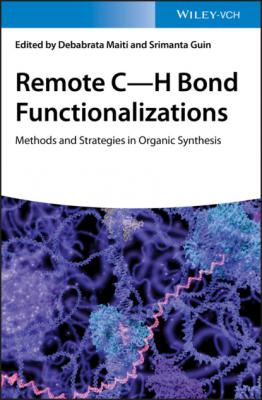Remote C-H Bond Functionalizations. Группа авторов
Читать онлайн.| Название | Remote C-H Bond Functionalizations |
|---|---|
| Автор произведения | Группа авторов |
| Жанр | Химия |
| Серия | |
| Издательство | Химия |
| Год выпуска | 0 |
| isbn | 9783527824144 |
In Chapter 8, Dutta and Maiti discussed about the recent progresses in the realm of distal arene para‐C–H functionalizations. Distinction of energetically comparable C
Chapter 9 deals with heterocycle functionalizations at unusual positions. Heterocycles are prevalent structural core in pharmaceuticals, natural products, and agrochemicals. Regioselective C–H functionalization of heterocycles is of paramount importance as the derivatization of these heterocyclic cores can alter their inherent properties. However, C–H functionalizations of hetero‐arenes are predominantly achieved at electronically biased positions. Therefore, standing against the innate inertness to attain selective C–H functionalization at unusual positions is of paramount importance in order to enrich the repertoire of heterocyclic compounds. The ever‐expanding inquisitive minds have dedicated their efforts in finding and devising suitable methodology to promote site selective C–H functionalization of apparently inert C
Unlike arene C(sp2)–H functionalization, aliphatic C(sp3)–H functionalization is relatively challenging due to its inherent inertness, low acidity, and overabundance with flexible long chain. Additionally, control over stereoselectivity is another important aspect to take care. Although functionalization of acidic C
Chapter 11 by Li and Zhu articulates the recent progresses on radical initiated distal C(sp3)–H functionalizations. Intramolecular hydrogen atom transfer process has provided a synthetically useful tool to promote regioselective functionalization of aliphatic substrates. Hofmann–Loffler–Freytag (HLF) reaction was considered as the pioneering invention in this realm. Although the potential of this strategy was realized lately in 2010, when a rapid growth was witnessed to promote radical initiated distal aliphatic functionalization via hydrogen atom transfer. In Chapter 11, comprehensive summary on different methods, synthetic applicability, and mechanistic intricacies are discussed from 2010 onwards.
Chapter 12 is devoted in discussing non‐directed functionalizations of aliphatic compounds, governed by innate reactivity. Although several challenges associated with the site selective functionalization of aliphatic substrates, constant up‐search in finding suitable protocols either by tuning the innate reactivity of particular C
While the sojourn through transition metal‐catalyzed distal C–H functionalization goes on in Chapters 2–12, in Chapter 13, Costas introduces to the territory of remote aliphatic C–H oxidation by bioinspired catalysis. Selective C–H oxidation is a routine task in biological system. The selectivity in enzymatic process is governed by the virtue of several interactions that enable the proper substrate trajectory and geometric orientation. Imitating such reactivity in laboratory synthesis is relatively challenging yet worthy to explore. Therefore, a persistent attempt to comprehend the mechanistic insight of biological reactivity and catalyst or ligand design was pronounced to furnish site selective functionalization of aliphatic substrate. A comprehensive survey on aliphatic C–H oxidation imparted by the bio‐inspired catalysis is outlined by Costas in Chapter 13.
The endless curiosities of human mind are the key to the technological advancements and evolution. This eternal truth has remained the essence for every piece of advancement since ancient times and will continue to remain persistent till times eternity. Modernization of scientific research in organic chemistry genre has shaped up in the form of C–H activation based protocols that has fostered a novel dimension in synthetic prospects and restructured the temperament of the scientific fraternity accordingly. This book besides providing a comprehensive scenario on the field of distal C–H activation also aims to inculcate cognizance among researchers of present and future generations to streamline and channelize their scientific understanding for the welfare of human civilization.
2 Transition Metal‐Catalyzed Remote meta‐C–H Functionalization of Arenes Assisted by meta‐Directing Templates
Yuzhen Gaoand Gang Li
State Key Laboratory of Structural Chemistry, Fujian Institute of Research on the Structure of Matter, Chinese Academy of Sciences (CAS), 155 West Yang‐Qiao Road, Fuzhou, Fujian, 350002,
